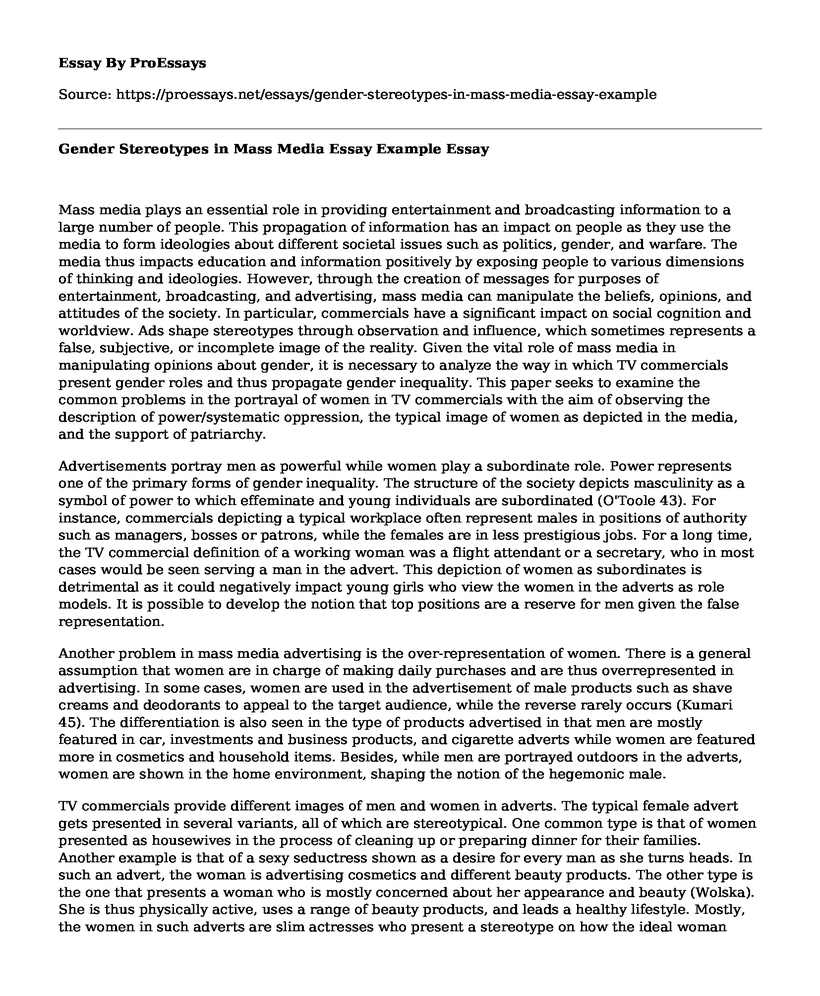Mass media plays an essential role in providing entertainment and broadcasting information to a large number of people. This propagation of information has an impact on people as they use the media to form ideologies about different societal issues such as politics, gender, and warfare. The media thus impacts education and information positively by exposing people to various dimensions of thinking and ideologies. However, through the creation of messages for purposes of entertainment, broadcasting, and advertising, mass media can manipulate the beliefs, opinions, and attitudes of the society. In particular, commercials have a significant impact on social cognition and worldview. Ads shape stereotypes through observation and influence, which sometimes represents a false, subjective, or incomplete image of the reality. Given the vital role of mass media in manipulating opinions about gender, it is necessary to analyze the way in which TV commercials present gender roles and thus propagate gender inequality. This paper seeks to examine the common problems in the portrayal of women in TV commercials with the aim of observing the description of power/systematic oppression, the typical image of women as depicted in the media, and the support of patriarchy.
Advertisements portray men as powerful while women play a subordinate role. Power represents one of the primary forms of gender inequality. The structure of the society depicts masculinity as a symbol of power to which effeminate and young individuals are subordinated (O'Toole 43). For instance, commercials depicting a typical workplace often represent males in positions of authority such as managers, bosses or patrons, while the females are in less prestigious jobs. For a long time, the TV commercial definition of a working woman was a flight attendant or a secretary, who in most cases would be seen serving a man in the advert. This depiction of women as subordinates is detrimental as it could negatively impact young girls who view the women in the adverts as role models. It is possible to develop the notion that top positions are a reserve for men given the false representation.
Another problem in mass media advertising is the over-representation of women. There is a general assumption that women are in charge of making daily purchases and are thus overrepresented in advertising. In some cases, women are used in the advertisement of male products such as shave creams and deodorants to appeal to the target audience, while the reverse rarely occurs (Kumari 45). The differentiation is also seen in the type of products advertised in that men are mostly featured in car, investments and business products, and cigarette adverts while women are featured more in cosmetics and household items. Besides, while men are portrayed outdoors in the adverts, women are shown in the home environment, shaping the notion of the hegemonic male.
TV commercials provide different images of men and women in adverts. The typical female advert gets presented in several variants, all of which are stereotypical. One common type is that of women presented as housewives in the process of cleaning up or preparing dinner for their families. Another example is that of a sexy seductress shown as a desire for every man as she turns heads. In such an advert, the woman is advertising cosmetics and different beauty products. The other type is the one that presents a woman who is mostly concerned about her appearance and beauty (Wolska). She is thus physically active, uses a range of beauty products, and leads a healthy lifestyle. Mostly, the women in such adverts are slim actresses who present a stereotype on how the ideal woman should look, leading to adverse effects on women viewers.
Conclusion
TV commercials are therefore crucial in developing stereotypes, whereby men are presented as powerful and dominant while women are seen as attractive and subordinate. However, the intention of the adverts is not always to depict women as weaker or men as stronger. The main reason for the nature of the adverts is to appeal to the target audience. Therefore, TV commercials examine societal beliefs and assumptions regarding men and women and utilize them to influence sales.
Works cited
Kumari, Archana, and Himani Joshi. "Gender Stereotyped Portrayal of Women in the Media: Perception and Impact on Adolescent." International Organization of Scientific Research, Journal of Humanities and Social Science (IOSR-JHSS), 20 (4) (2015): 44-52.
O'Toole, Autumn M. "Portrayals of Gender in the Media: A Content Analysis Approach to Identifying Gender Oppression and Legitimation of Patriarchy in Magazine Advertisements." (2016).
Wolska, Malgorzata. "Gender stereotypes in mass media. Case study: Analysis of the gender stereotyping phenomenon in TV commercials." Krytyka. org 9 (2011).
Cite this page
Gender Stereotypes in Mass Media Essay Example. (2022, Nov 08). Retrieved from https://proessays.net/essays/gender-stereotypes-in-mass-media-essay-example
If you are the original author of this essay and no longer wish to have it published on the ProEssays website, please click below to request its removal:
- The Movie Reflection Paper Example: The Mystery of Matter
- A Heated Discussion Between Playwrights
- Police Use of Social Media Revolutionizes Criminal Investigations - Essay Sample
- Designing User-Centred Prefabricated Family Houses in Denmark - Essay Sample
- Movie Analysis Essay on Rock With Wings
- Witnessing the American Civil Rights Movement: A Journey of Liberation & Equality - Essay Sample
- Free Essay on Navigating Societal Norms: An Exploration of Social Interaction through Eye Contact







